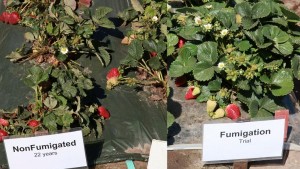Late last year, just before Governor Schwarzenegger left office, his administration approved a controversial strawberry pesticide called methyl iodide. Environmental groups quickly sued to have the decision overturned.

A key question posed by the plaintiffs was this: Why was the state's Department of Pesticide Regulation (DPR) allowing farmworkers to be exposed to methyl iodide at levels more than 100 times higher than what the agency's own staff scientists believed was safe?
When pressed for documents that might reveal the agency's rationale, the then-head of the DPR, Mary-Anne Warmerdam, declined to release them, saying they were legally protected by what's called the "deliberative process" exemption under the California Public Records Act; this allows some of the back-and-forth between agency decision makers and their advisors that preceded a particular decision to be kept private under certain circumstances. A public records act request filed by KQED elicited the same response.
Earlier this month, a judge disagreed (.pdf) and ordered the DPR to release the documents, which plaintiffs shared with reporters on Thursday.
The documents show a deep rift within the DPR, between staff scientists who believed that methyl iodide was too hazardous for farmworkers, and the DPR managers, led by Warmerdam, who approved it.
Referring to the DPR's explanation for why it had approved methyl iodide, Jay Schreider, the Primary State Toxicologist wrote, "I am puzzled by the numbers cited." Warmerdam's methods for reaching the agency's allowable exposure levels were "not scientifically credible," wrote Schreider.